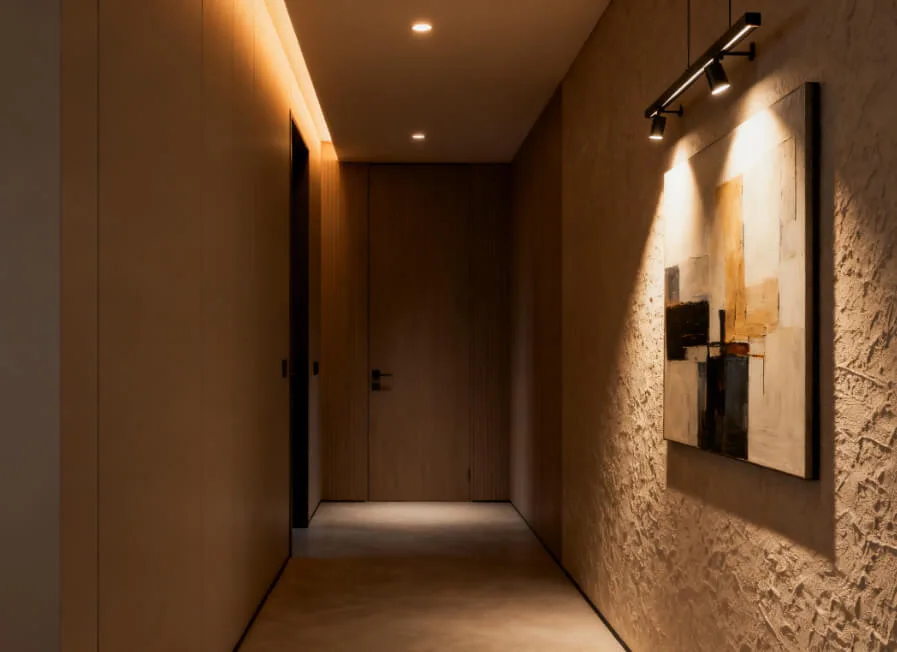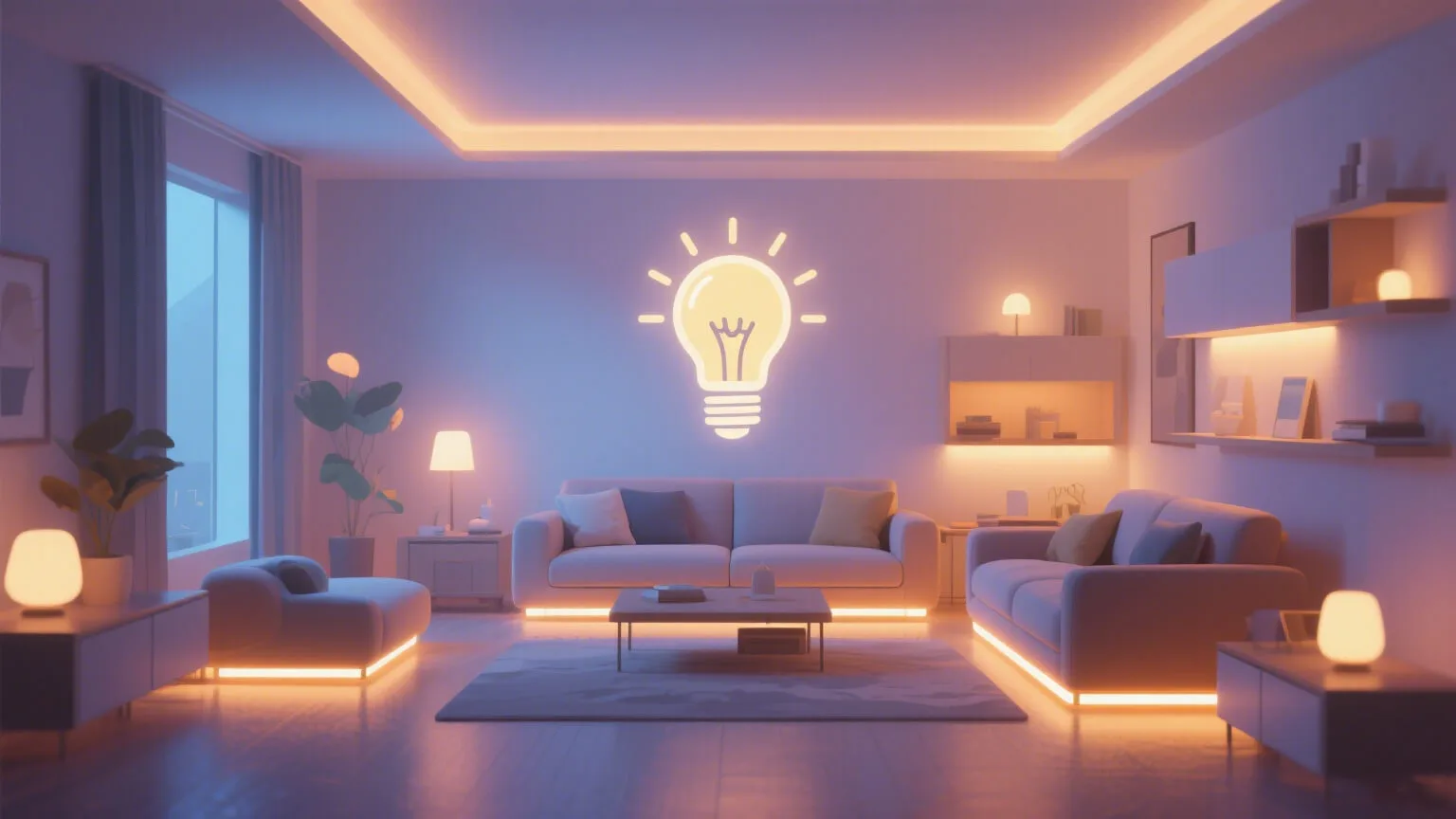From Hidden Lighting to Smart Dimming, Unlocking the Luxurious Secrets of Light and Shadow Aesthetics
Introduction: Why Do High-End Spaces Need LED Linear Lights?
In the era of pursuing “high-end aesthetics,” lighting has transcended its basic functionality to become the soul of spatial design. Traditional ceiling lights or chandeliers often appear bulky and rigid, while LED linear lights, with their minimalist linear design, flexible light control, and seamless integration with materials, have become the “magician of light and shadow” in designers’ hands. Whether in homes or commercial spaces, they can effortlessly outline a luxurious atmosphere with subtle lines.
Part 1: The Essence of High-End Spaces—Invisible Lighting, Visible Texture
1. What Defines a “High-End” Space?
- Simplicity Without Blandness: Eliminate redundant decorations, conveying taste through clean lines and material contrasts.
- Light and Shadow Layering: Avoid flat lighting with single light sources, creating depth through contrasts of brightness and darkness.
- Dialogue Between Materials and Light: The interplay of light with materials like marble, metal, and glass amplifies texture details.
2. Why Are LED Linear Lights Key to High-End Design?
- Ultra-Slim and Invisible: With widths as narrow as 10mm, they achieve a “light without visible fixtures” effect.
- High Color Rendering Index (CRI>90): Accurately restores material colors, avoiding a cheap plastic appearance.
- Flexible Control: Supports dimming and color temperature adjustment, adapting to different scene moods (e.g., 3000K warm light for coziness, 4000K cool light for focus).
Data Support:
“Research shows that high-CRI lighting can enhance spatial color perception by 30% (Source: International Commission on Illumination).”
Part 2: 5 Design Tips to Elevate Spaces with LED Linear Lights
Tip 1: Hidden Installation—Light Without Visible Fixtures
Core Idea: Embed light sources into architectural structures, creating a soft ambiance through reflected light.
- Home Applications:
- Living Room: Install linear lights in ceiling recesses to replace main lights, making the space feel more open.
- Wardrobe: Embed lights inside shelves to showcase clothing like a high-end display.
- Commercial Applications:
- Hotel Corridors: Embed linear lights in the floor to guide the eye while avoiding glare.
Pitfall Alert:
Leave maintenance access points to avoid future difficulties; choose low-voltage (24V) strips for safety.
Tip 2: Linear Space Division—Enhancing Architectural Structure
Core Idea: Use light to outline spatial contours, emphasizing geometric lines and depth.
- Home Examples:
- Stairs: Embed lights under steps for safety and design appeal.
- TV Wall: Use vertical linear lights to divide the wall, visually increasing ceiling height.
- Commercial Examples:
- Exhibition Halls: Outline display stands with linear lights, making exhibits the focal point.
Design Inspiration:
“Linear lighting along walls can visually expand small spaces by 20%.”
Tip 3: Color Temperature and Scene Coordination—Adapting to Spatial Moods
Core Formula:
- 3000K Warm Light: Living rooms, bedrooms, dining areas (cozy and relaxing).
- 4000K Neutral Light: Study rooms, offices (efficient and focused).
- RGB Dynamic Light: Bars, exhibition spaces (tech-savvy and artistic).
Smart Upgrade:
Control via smartphone apps or voice assistants (e.g., HomeKit, Mi Home) to switch scenes with one tap.
Tip 4: Material Interaction—The Chemistry Between Light and Surfaces
Pairing Formula:
- Marble + Warm Light: Reflects soft glow, enhancing luxury.
- Metal + Cool Light: Amplifies the cold, industrial aesthetic.
- Wood + Diffused Light: Creates a natural, warm, wabi-sabi ambiance.
Pitfall Alert:
Avoid direct light on mirrors or glossy surfaces to prevent glare; opt for anti-glare covers or indirect lighting.
Tip 5: Dynamic Light and Shadow—Creating Visual Focal Points
Core Technique:
- Accent Lighting: Use linear lights to highlight artworks, bars, or brand logos.
- Gradient Effects: Smart control of color transitions for immersive experiences (e.g., sunset simulation in private dining rooms).
Commercial Example:
A luxury store used dynamic linear lights to guide customers to new collections, increasing sales by 15%.
Part 3: High-End Space Inspiration Gallery—From Homes to Commercial Scenes
1. Home Scenes
- Minimalist Living Room:
- Floating ceiling + recessed linear lights paired with low-profile furniture, creating a “floating loft” effect.
- Luxurious Bathroom:
- LED strips around mirrors for shadow-free makeup; marble countertops reflecting subtle light.
2. Commercial Scenes
- High-End Showroom:
- Linear lights flowing along display stands, making products look like museum pieces.
- Private Dining Room:
- Warm linear lights hidden in walls, creating a private and luxurious atmosphere.
Part 4: Pitfall Guide—5 Mistakes That Make Lighting Look Cheap
- Overly Bright or Dim Lighting: Calculate required lumens (100-300 lumens/㎡ for homes).
- Mismatched Color Temperatures: Maintain consistent color temperature in open spaces.
- Visible Light Strip Joints: Choose seamless models and measure precisely during installation.
- Ignoring Flicker Issues: Look for flicker-free certifications (e.g., IEEE 1789 standard).
- Choosing Low-Quality Lights: Rapid light decay and poor color rendering reveal flaws within months.
Part 5: Product Buying Guide—How to Choose the Right Lights
- Key Parameters:
- CRI>90, adjustable color temperature, IP rating (choose IP65+ for bathrooms).
- Brand Recommendations:
- Budget-Friendly: Yeelight, Philips Hue
- High-End Custom: ERCO, FLUA
- Accessories Checklist:
- Transformers, connectors, aluminum channels (for heat dissipation and durability).
CTA (Call to Action):
“Click now to get a free lighting design plan and customize your high-end space!”
Conclusion: High-End Design Lies in the Details
The charm of LED linear lights lies in using the simplest lines to craft the most complex aesthetics. They are not just lighting tools but also the directors of spatial emotion. Whether through the restraint of hidden designs or the boldness of dynamic lighting, they elevate spaces from mediocrity to the epitome of “high-end.”



